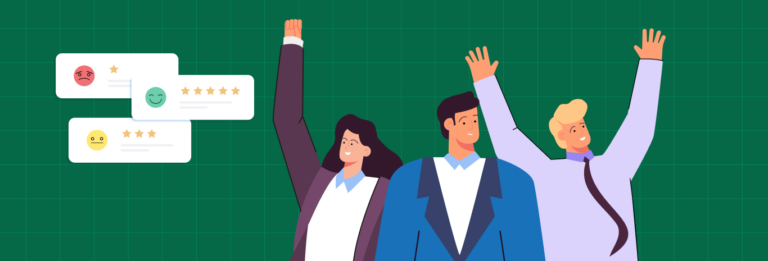As remote and hybrid work models are gaining momentum, digital employee experience has become an integral part of employee experience strategy. More and more companies are realizing the importance of providing centralized platforms and necessary tools to accommodate remote employees.
An employee-centric digital employee experience platform (DEX) not only streamlines employees’ daily tasks but also reduces the overwhelming burden on the HR. Enhancing the digital employee experience empowers individuals and helps the organization. But, for an improved employee experience, specific points must be thoroughly understood before incorporating a digital employee experience platform.
To make the task easy for you, we have compiled this guide that will answer your questions on the practical implementation of a DEX strategy, how it will benefit your business and other intricate details.
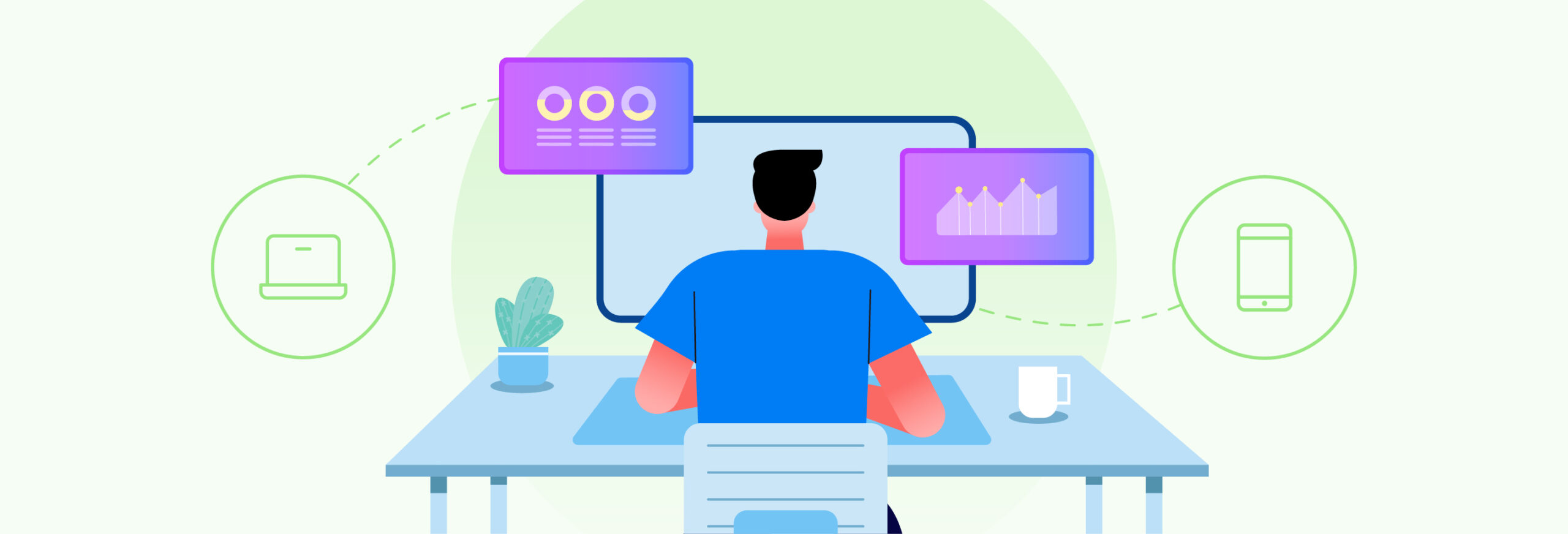
What is a digital employee experience?
Digital employee experience or DEX is an employee’s entire experience with various digital setups provided by the company. The modern workplace involves dealing with technology for everyday tasks. DEX reflects how well employees use the organization’s digital tools to be more efficient and productive in their jobs.
DEX has become significantly popular among businesses as it bridges the gaps between digital transformation and employee experience. A proficient digital employee experience strategy has multifaceted benefits. Interfacing technology in the system helps with workflow, communication between employees and the IT department, seamless team collaboration, and an efficient HR system.
In simple words, employees can carry out their daily tasks, the IT team can run their operations smoothly, and HRs can efficiently manage all the employee-related tasks in a jiffy.
Why is employee experience critical in today’s market?
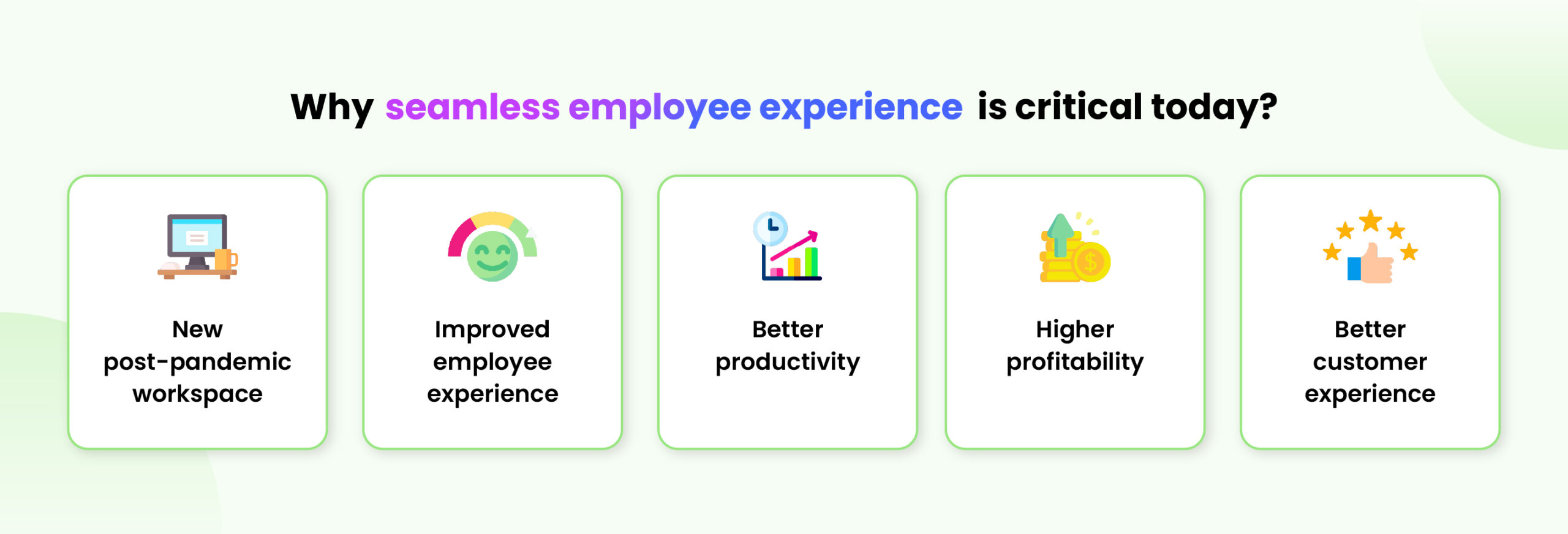
Digital employee experience has become an indispensable part of employees’ journey throughout industries. With the evolution of the global market and competition, technology has become essential in all operations as a prerequisite for success.
Digital employee experience software simplifies employees’ tasks, giving them more time to invest their skills in the quality of work. It makes employees more satisfied and supports them in delegating their job roles.
Let us look at why a prominent DEX solution is critical to staying relevant in today’s market.
Post-pandemic workspace
In the wake of the pandemic, remote and hybrid work models became the norm. With that began the undeniable necessity to implement digital employee experience tools so that the employees can work from any location without missing out on any critical details or communication.
A McKinsey study has found that 52% of workers prefer hybrid work models, and 30% stated that they might switch jobs if the on-site work model is restored. So it is evident that post-pandemic work models are here to stay.
DEX solutions enable employees to adapt to flexible work models without feeling left out. These platforms contribute to holistic employee experience by making your employees feel valued and connected even when they are not working on-site.
Improved employee experience
DEX solutions can significantly improve overall employee experience by providing the employees with cutting-edge resources and tools. It is now considered as a crucial subpart of the employee experience as it helps retain talent and attract skilled candidates.
According to a survey by Vason Bourne, 73% of respondents shared that the flexibility of tools such as technology, apps, and devices used by a company would influence their decision to apply for or even accept a position there. Moreover, ESI ThoughtLab has found that 54% of employees think DEX is a significant factor in deciding whether to stay in their current organization.
Employees with access to essential tools are more likely to be engaged in their daily tasks. Since an engaged employee is happy, digital employee experience notably improves employee experience.
Better productivity
Without sufficient tools and efficient devices, your employees find it challenging to complete their tasks on time.. Technology simplifies their work and streamlines hassle-free communication across teams on remote and on-site work models.
If your staff doesn’t have adequate resources and tools at their disposal, they have to navigate through an inefficient system. That takes up a lot of their time and energy and leaves little room for innovation and creative solutions.
But with a user-friendly digital employee experience platform, employees can get work done more accurately and efficiently in significantly less time. With features like an intuitive dashboard and progress monitor, employees can manage their work efficiently, boosting collective productivity in the workplace.
Higher profitability
When your workforce is well-equipped with the tools they require to perform their daily tasks, they thrive in their responsibilities and all-around performance – which translates to higher revenue.
Productive and engaged employees get work done quickly and develop innovative ideas, contributing to the overall business’s profitability. This is how digital employee experience software is paving the path towards financial growth In the modern-day business scenario.
Better customer experience
When your employees have access to the best DEX solutions, they provide a better customer experience, leading to increased customer acquisition. Forbes has cited that employee experience and customer experience are intertwined. Research shows that companies with fantastic customer experience records boast 1.5 times more engaged employees. Moreover, companies with engaged employees perform better than their competitors by 147%.
Your employees are the company’s brand ambassadors. Therefore, equipping them with effective digital employee experience solutions will assist them in promoting the organization’s guiding principles and overall objective. This will contribute to developing a committed staff that appreciates the importance of offering high-quality services to clients.
Who is involved in delivering employee experiences to your workforce?
While traditionally, a company’s HR department was primarily responsible for dealing with employee-related issues, it is not the case anymore.
Employees’ experience is subjected to every encounter and interaction they have in the workplace. From management to IT, all have a remarkable effect on improving employee experience. Let us look at each position’s various parts to improve the employee experience.
 HR department
HR department
A company’s HR department deals with acquiring talent, onboarding new hires, listening to the employees, keeping track of documents, and mitigating any necessary resolution. HR professionals act as the bridge between the employees and the leadership and ensure that each department plays its part in creating a healthy work environment. By building a culture of appreciation and healthy communication, HR departments work towards improving employee experience.
 Managers
Managers
Employees look up to their managers for guidance and feedback. Poor management can severely impact the employee experience, lowering morale and motivation. Many employees quit jobs to escape incompetent management.
Despite smooth HR functions, it is important to have effective management capable of delivering employee performance and delegating staff to align with the company’s vision. Ideal managers give employees autonomy on projects, give frequent feedback and praises, listen to their teams, and act as employees’ mentors.
 Leaders
Leaders
The responsibility to set the tone of the company lies in the leadership. They approve policies in the company’s and the employee’s best interests. Every business has its ups and downs, and employee experience can be hugely affected based on those situations.
At the top tier of a company, the leadership strategically navigates through the highest and lowest points. Employees who feel that the employers are committed to their well-being tend to develop loyalty and trust towards the organization.
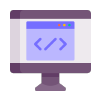 IT Teams
IT Teams
It is evident that digital employee experience is imperative for a better employee experience. The IT department is responsible for setting up and maintaining digital employee experience software and tools; it also plays a vital role in providing a satisfactory employee experience.
IT teams build the company’s technical infrastructure and make the employees familiar with its intricacies. When any disturbance or issue arises in the system, the tech people are the ones who resolve them. If the IT department doesn’t perform its jobs effectively, productivity in a DEX system suffers. They are at the heart of balancing quick technical resolution with increasing productivity.
What are the challenges organizations face today in delivering a great employee experience?
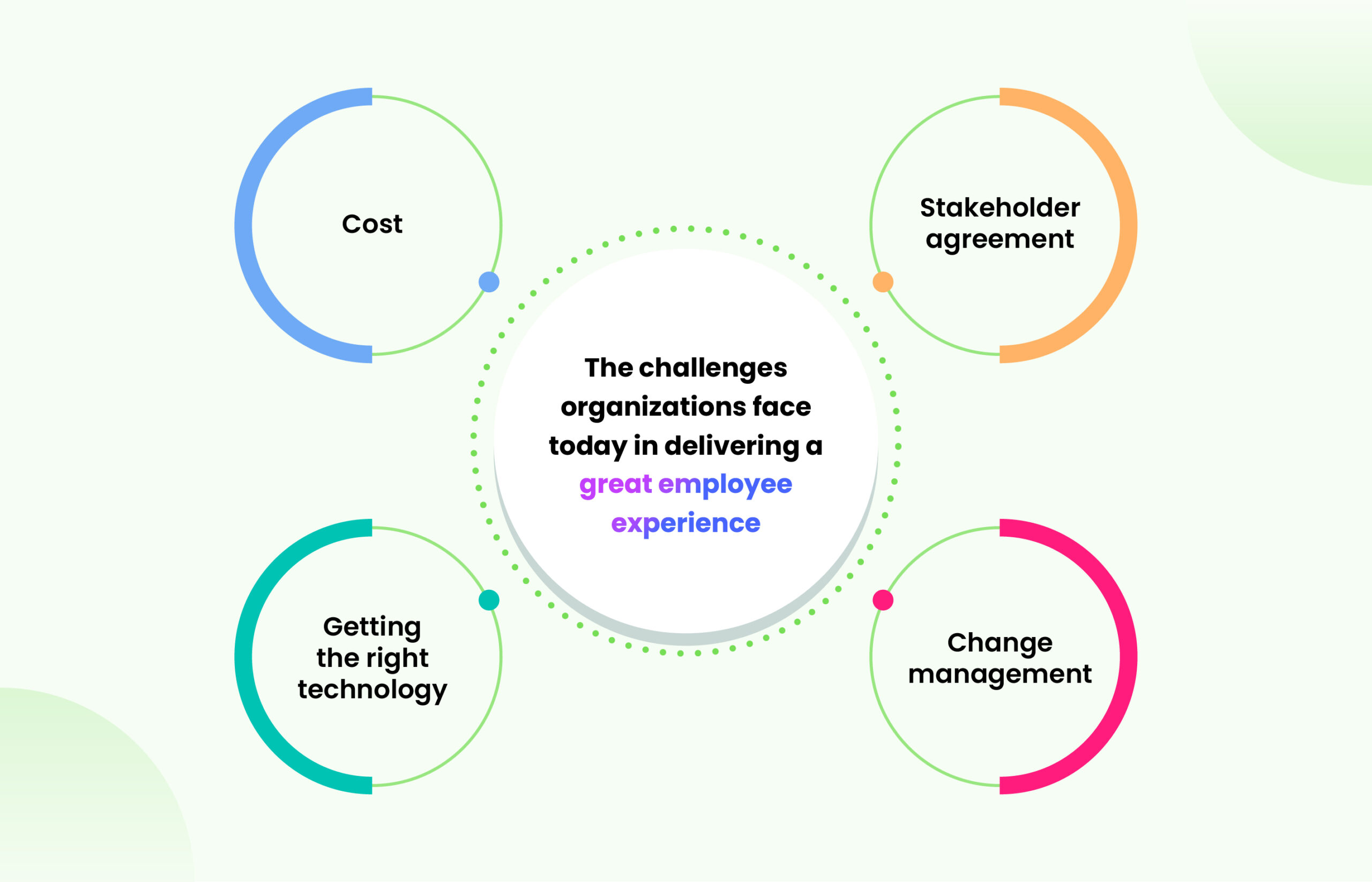
While integrating efficient DEX tools promises impactful results like increased engagement, productivity, and more, however, the effective implementation of such technology can be tricky. An organization has to overcome several hurdles before a full-fledged employee experience transformation. Below are some common roadblocks in delivering a practical digital employee experience.
Cost
The onset of the pandemic has impacted cash flow in the market. So, many companies are dealing with a tight budget for running everyday functions. The same applies to IT spending as well. As DEX system implementation involves significant financial investments and is a relatively new concept, obtaining the budget and resources for it is difficult.
Stakeholder agreement
Digital employee experience has a long way to go before it becomes mainstream in the industry. So , convincing the leadership to be on board with the digital transformation tool for improving employee experience is another hurdle in prioritizing technology.
Not all employees are receptive to new technologies; you may have staff whose familiarity with the most recent tools and platforms advances slowly. So it will take time to make every stakeholder feel comfortable with the concept of dealing with digital employee experience software.
Getting the right technology
Digital employee experience will only generate visible results when your company opts for the appropriate technology. You need a suitable partner for tech to support your employees and your organization’s goals. The tools and overall system have to be comprehensive, user-friendly, and intuitive. If your chosen digital employee experience platform complicates operations instead of streamlining them, it will bring more problems than benefits.
Change management
Implementation of DEX will bring with it the necessity of a significant shift in the traditional management approach. Employees and managers must receive proper training in order to operate the digital employee experience tool, and software and operational procedures must be altered.
How do you design an excellent digital employee experience?
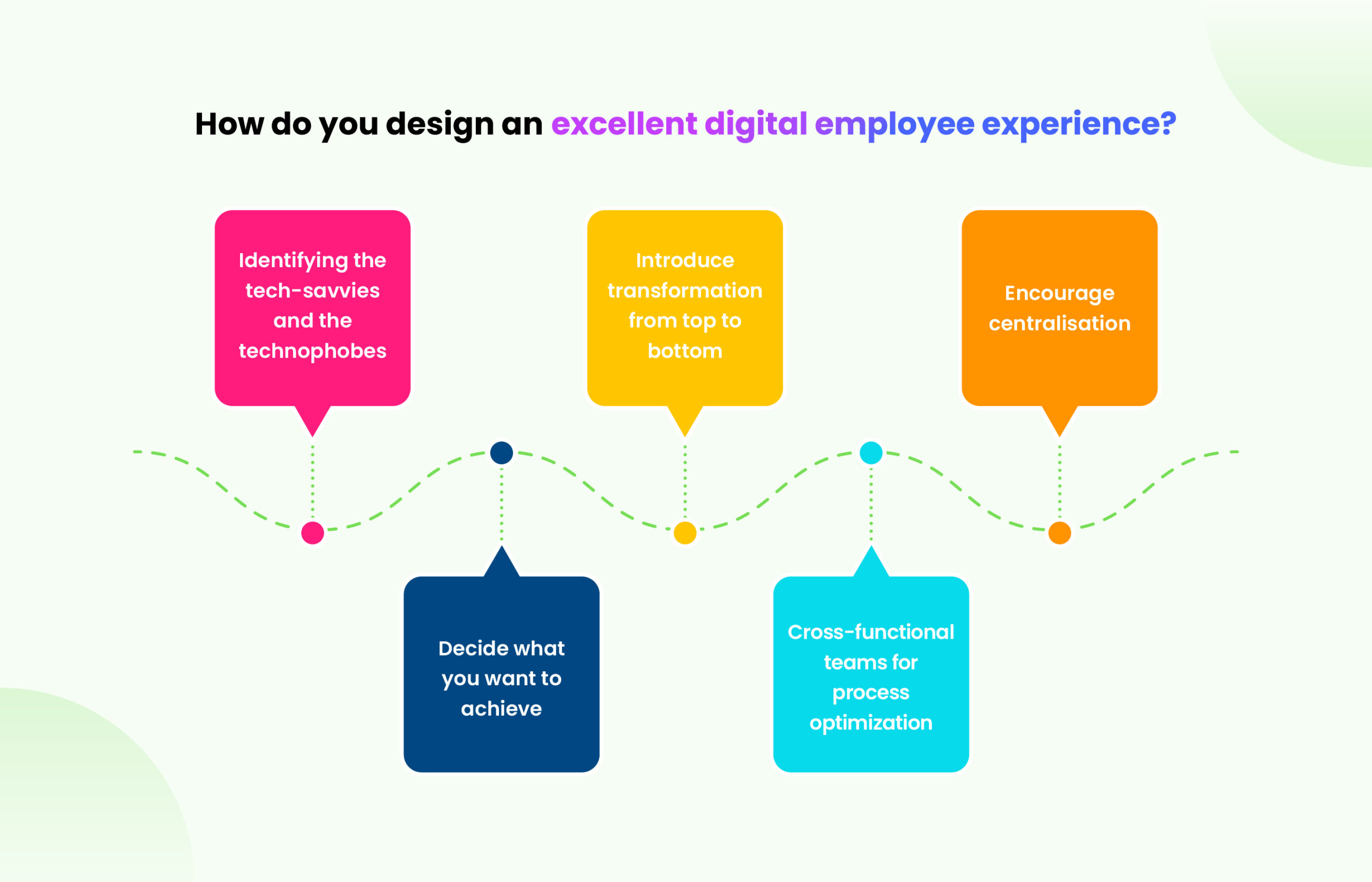
Digital employee experience is a two-way street – it reflects how employees deal with technology and how IT teams work with the employees. So for the effective implementation of DEX software, a proper strategy needs to be in place.
Below are the steps an enterprise should keep in mind while infusing DEX into their day-to-day operations for a better employee experience.
Identifying the tech-savvies and the technophobes
Every employee interacts with technology differently. For proper implementation, it is crucial that you identify different employee personas and their ways of dealing with technology. This will help you to structure a practical digital employee experience that is diverse and inclusive.
Decide what you want to achieve
Create a clear vision of your goals regarding the implementation of DEX. You need to choose a software according to the needs of your industry. If you have a clear goal, it will be easy to choose and integrate the necessary tools, functions, automation, etc. Planning out a vision would help you to strategize appropriate learning and development L&D programs to familiarize your employees with the transformation.
Introduce transformation from top to bottom
If you can implement a management transformation compatible with technology, it will lead to the gradual adoption of technology in the workplace. Any change would cause unease. Therefore, you must be constant in your approach.
Cross-functional teams for process optimization
Implementing an acquisition system would aid in maintaining a continuous workflow. Ensure that teams from all departments offer adequate input from various functions to avoid a slow and stagnant process.
Encourage centralisation
Implement a DEX system that incorporates centralized data storage. It will lead to a unified pool of ideas and innovations that can be easily accessed and applied to different projects. A centralized system also makes it easy for the employees to access and use different resources and collaborate with their colleagues on different tasks.
How do you improve the digital employee experience?

1. Appropriate learning and development programs
Employees who are used to the on-site work model may not instantly understand remote work tools. For DEX systems to work, you must thoroughly prepare your employees and equip them with the necessary knowledge of handling technology.
So it is imperative that you communicate what you want to achieve with such technical implementation. This will give them the idea of when and how to use proper tools for different tasks. One easy way of familiarizing your remote employees with an automated digital employee experience system is to create walk-through videos explaining the features and functions of each tool. They can easily access such visual resources whenever needed and quickly learn to work with digital transformation.
2. Gather data and work on improvements
Your job doesn’t end with the initial implementation of a digital employee experience platform. For the system to work, constant monitoring and improvements are also necessary. Frequent employee surveys will provide information and insights on what gaps to fill and how to improve the system for a better employee experience.
With the right technology, gathered feedback can be automatically analyzed, identifying the exact pain points. This will allow you to take the necessary steps for an improved digital employee experience
3. Implement a common networking platform
For a better digital employee experience, you need to facilitate bonds between your remote and on-site employees. Connecting with their colleagues in a unified platform prevents your employees from feeling left out and develops synergy within teams.
4. Equitable treatment of both remote and on-site staff
Despite the fact that there will be disparities between the employees you see every day and those who work remotely, ensure that your remote workers do not feel undervalued and uninvolved. Make it a priority to check in with the remote personnel frequently. A brief video chat or tailored message will enhance the digital employee experience considerably.
5. Automated shoutouts, reminders, and rewards
Optimize the DEX system to set up automatic reminders and shoutouts on your employees’ personal and professional achievements. You can also deliver birthday rewards to make the remote employee feel like they are a valued member of your organization.
How a digital employee experience benefits the organization?
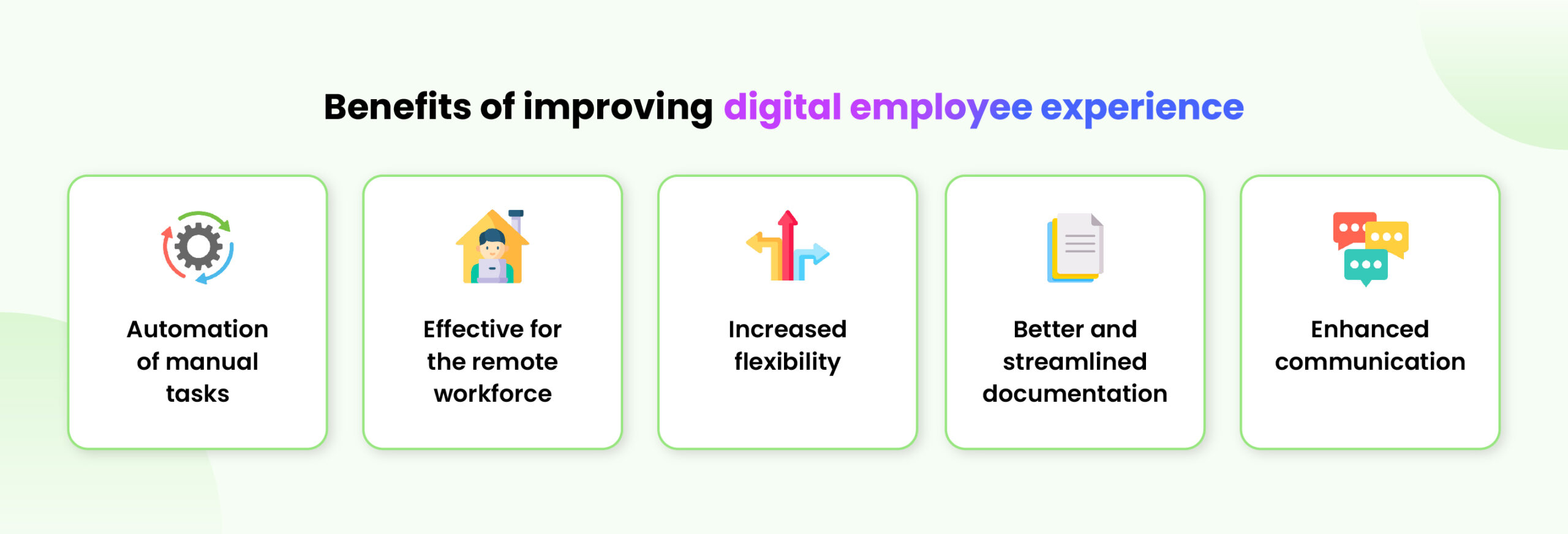
Automation of manual tasks
Implementation of digital employee experience leads to better productivity because it gets rid of the tedious manual processes. An automated system takes care of the monotonous but necessary parts of your employee’s daily tasks and gives them the time to be innovative with their responsibilities. Automated tools eliminate workplace frustration and help in increasing the positivity quotient of employee experience.
Automation does not let HR departments feel overwhelmed with mundane tasks This way, they get enough time to focus on improving the employee experience.
Decreased need to travel to in-person meetings
Effective DEX platforms are centralized and are a significant part of remote employees’ day-to-day functions. Such systems streamline virtual meetings, and remote employees can conveniently attend meetings without commuting to the office.
Increased flexibility
A digital workplace allows flexibility to employees. As the resources, data and tools can be accessed anytime; employees can complete their tasks with flexible schedules. This way, employees can maintain better work-life balance without compromising on productivity.
Better and streamlined documentation
Automated digital employee experience software replaces the need for physical paperwork and streamlines easy documentation. Both new hires and employees don’t have to go through complicated documentation and updating procedures. This contributes to the overall employee experience.
Automated onboarding and offboarding allow a centralized record of data that can be accessed by authorized employees whenever required. With self-service features, staff can update and access their details from remote locations without navigating their way through a complicated chain of departments.
Enhanced communication
Digital employee experience strategy encourages two-way communication between lower-level and higher-level employees. A well-constructed digital workplace allows employees to collaborate, learn, and exchange ideas with different teams.
The centralized platform also makes it easier for new hires to build a bond with their colleagues and be comfortable in the new work environment. Such seamless communication adds to the employee experience and benefits the company.
To Sum up
When the right technology assists your employees in doing their jobs, accessing resources, and being self-sufficient, it has a powerful and positive impact on their experience. From onboarding to offboarding, your employees deserve to feel valued. A proper digital employee experience strategy enables a professional journey much easier. Your employees must be engaged and experience a healthy and helpful work environment to be able to work at the best of their potential. With increasing growth, personalized attention to every employee becomes an impossible task and can negatively affect employee experience. Thus, leveraging technology is necessary for a business to succeed.
That’s where Leena AI can help you.
With its automated chatbots, comprehensive and clean dashboard, advanced analytics, and industry-best DEX tools, your employees can complete their tasks without experiencing burnout and drive the success of your business. So, for an improved digital employee experience, choose Leena AI today.






